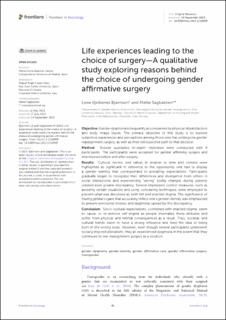| dc.description.abstract | Objective: Gender dysphoria is frequently accompanied by physical dissatisfaction and body image issues. The primary objective of this study is to explore subjective experiences and perceptions among those who has undergone gender reassignment surgery, as well as their retrospective path to that decision.
Method: Sixteen qualitative in-depth interviews were conducted with 9 participants. The participants were accepted for gender affirming surgery and interviewed before and after surgery.
Results: Cultural norms, and values in relation to time and context were highlighted as significant in reference to the opportunity one had to display a gender identity that corresponded to prevailing expectations. Participants gradually began to recognize their differences and divergence from others in social interactions and experiencing “wrong” bodily changes during puberty created even greater discrepancy. Several impression control measures, such as avoiding certain situations and using concealing techniques, were employed to prevent what was described as both felt and enacted stigma. The significance of having genital organs that accurately reflect one’s gender identity was emphasized to prevent emotional distress and dysphoria caused by this discrepancy.
Conclusion: Socio-cultural expectations, combined with enacted stigma, seem to cause, or re-enforce self-stigma as people internalize these attitudes and suffer from physical and mental consequences as a result. Thus, societal, and cultural trends seem to have a strong influence and feed the idea of being born in the wrong body. However, even though several participants underwent socially inspired alterations, they all experienced dysphoria in the extent that they continued to see reassignment surgery as a solution. | en_US |

